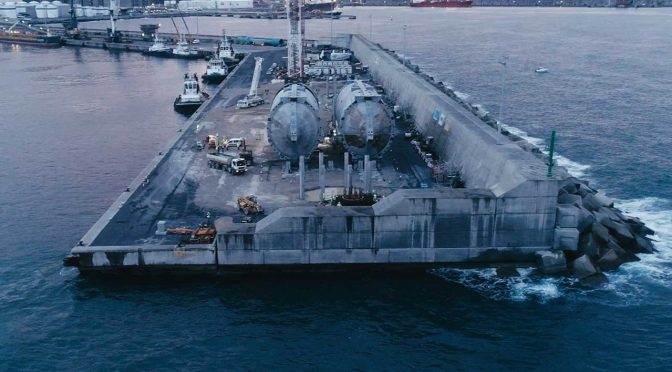A study funded by RWE, one of the world’s leaders in offshore wind, concludes that Scotland could become a world leader in producing low carbon concrete foundations for floating offshore wind farms. The study identified potential business opportunities from the current ScotWind seabed leasing round, and calls on Scottish politicians, project developers, suppliers and industry experts to join forces and investigate how best to unlock the potential, while maximising opportunities for local investment.
The study closes an important gap in the industry’s understanding of the scale and business potential of producing concrete foundations for floating offshore wind farms. It also further expands RWE’s knowledge of floating offshore wind, gained from three major floating wind technology trials it is undertaking with partners around the world.
Carried out in partnership with researchers at the UK’s Offshore Renewable Energy (ORE) Catapult, through its Floating Offshore Wind Centre of Excellence (FOWCOE), the study was also supported by offshore wind industry experts at the Concrete Centre.
Floating foundations use both steel and concrete designs, but most research in the UK to date has focused on steel designs. The study addressed this by testing the feasibility of a production facility, capable of building 33 concrete floating foundations for 15 megawatts (MW) turbines each year.
Researchers reviewed Scotland’s existing experience and capabilities for producing specialist concrete focused on using low carbon methods and materials. It found that both Scottish ports and industry have existing experience and skills from producing concrete at scale that can be applied to this low carbon alternative. The country is therefore well placed to manufacture the foundations, attracting significant investment into the Scottish and UK supply chain.
Ralph Torr, Programme Manager, ORE Catapult’s Floating Offshore Wind Centre of Excellence said: “Floating offshore wind presents Scotland with significant opportunities, but these come with some industrial challenges. Delivering the anticipated capacity of floating offshore wind will require scale-up and repurposing of supply chain capacity as well as the creation of new capabilities. That is why this assessment of the role that the concrete supply chain in Scotland can play in delivering large-scale floating wind projects is such an important step. It opens up new possibilities for Scotland’s leadership of floating offshore wind and how it can translate into tangible economic benefit.”
In terms of scale of opportunity, the study noted that just a single project would require a volume of low carbon concrete potentially up to four times greater than that needed to build one of Scotland’s largest infrastructure projects, the Queensferry Crossing.
It also said that to keep costs low and reduce carbon footprint, concrete production should take place at or close to the quayside where the foundations would be deployed. It identified that there are four Scottish ports – Hunterston, Kishorn, Port of Cromarty Firth (Invergordon) and Ardersier, as well as clusters of potential sites, including the Cromarty Firth and the Forth and Tay, which could potentially meet the capacities required.
The study found that industry would need to invest significantly to ensure the infrastructure is in place to deliver the requirements. It called for more industry-wide work to investigate the business case for developing such a facility, and the steps required to trigger such investment.
RWE is already one of the world’s leading offshore wind companies and is driving the development of the largest offshore wind pipeline in the UK. The company is committed to accelerating the growth of its capacity to produce clean energy and, through its recently announced Growing Green strategy, RWE has committed to investing €50 billion gross through to 2030 to expand its green generation capacity to 50 gigawatts, with some £15 billion earmarked for the UK, including for floating offshore wind projects in Scotland.
RWE and floating offshore wind
RWE is well on track to become a leader in floating wind and to have 1 GW either in operation or under construction by 2030. The company is pioneering three floating offshore wind projects with partners, two of which use concrete foundation designs. In Spain, RWE is working with Saitec Offshore Technologies on the DemoSATH project, a concrete twin-hull barge structure, made of modular, pre-fabricated components. It is expected to go into operation mid-2022. For its New England Aqua Ventus project in the US, RWE is in partnership with Diamond Offshore Wind and the University of Maine to deploy a concrete semi-submersible structure. The project will use a 11 MW turbine and is expected to go into operation in 2024. The most advanced project is the TetraSpar Demonstrator project, which is currently being commissioned off the Norwegian coast near Stavanger in waters as deep as 200 metres.

“Floating offshore wind and the current ScotWind leasing round represent a huge opportunity to develop a world-leading industry in Scotland. This report, commissioned by RWE, demonstrates the significant business potential from the manufacture of low carbon concrete foundations, and makes clear that Scotland is best placed to realise that. Committed to invest around £15 billion through 2030 to expand its clean energy capabilities in the UK, including Floating Wind, RWE is keen to work in collaboration with all parties to maximise these opportunities for the country’s economy and workforce.”
Tom Glover, UK Country Chair, RWE
Pictures of concrete foundations for the demoSATH project in which RWE is a partner, for media use (credit: Saitec Offshore Technologies) are available at the RWE Media Centre.
You can read the full report here.


